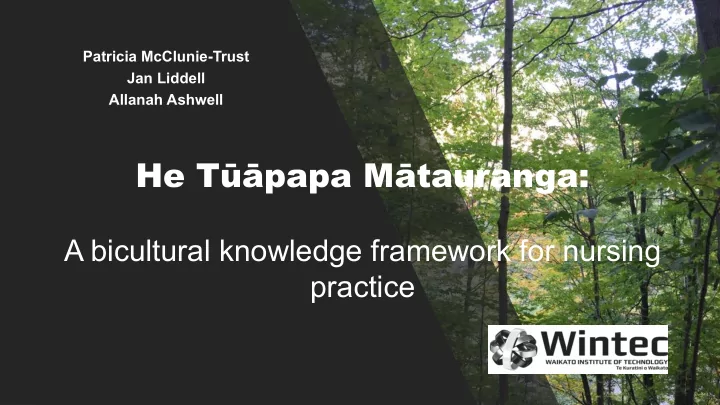

Patricia McClunie-Trust Jan Liddell Allanah Ashwell He Tūāpapa Mātauranga: A bicultural knowledge framework for nursing practice
Tena koutu katoa Jan Liddell Tihei Mauri Ora Centre for Health and social practice Waikato Institute of Technology Member Wharangi Ruamano (Maori Nurse Educators) Patricia McClunie-Trust Principal Lecturer Postgraduate Nursing Centre for Health and Social practice Waikato Institute of Technology
He Tūāpapa Mātauranga This presentation explores a bicultural model for ngā momo mōhiotanga or ‘ways of knowing’ in nursing as a unique, culturally inclusive approach to thinking and reasoning for nursing practice in Aotearoa, NZ.
Why is biculturalism important? The need for new translations (Bishop et al., 2014; Hickey & Wilson, 2017) Rationale – demographics of Waikato region (Robson et al., 2016) Noticing the need to call bicultural practices into the classroom (Glynn, 2015) Wintec Teaching and Learning Directions 2017-2020
What lead us to translate this framework? Our passion is that we strive to make our education practice inclusive in ways that • enable Māori nurses to recognise their freedom to practice authentically as nurses • bring Te Reo into the classroom for all nurses • work to create a paradigm shift in nursing; to Manaaki or support nurses to care for people and their families or whānau
He Tūāpapa Mātauranga Mōhiotanga ā-mahi • e xperiential knowing Mōhiotanga ā-taunakitanga • e mpirical knowing Mōhiotanga ā-iwi • c ontextual knowing Mōhiotanga ngaio • professional knowing (Higgs & Jones, 2008; Skovolt & Starkey, 2010)
Mōhiotanga ā-mahi “e xperiential knowing ” Mōhiotanga ā-mahi or e xperiential knowing represents the ‘ready to hand’ knowledge nurses bring to clinical reasoning. Derived from prior experience of similar situations, it enables nurses to make sense of, and prioritise responses to, clinical situations.
Mōhiotanga ā-taunakitanga “empirical knowing” Mōhiotanga ā-taunakitanga or e mpirical knowing is the propositional knowledge that provides the frameworks, models and best evidence that guide practice.
Mōhiotanga ā-iwi “c ontextual knowing” Mōhiotanga ā-iwi or c ontextual knowing requires an understanding of clients’ priorities, cultural practices, capabilities and other interests, including the significance of epidemiological patterns of health and illness and health disparities.
Mōhiotanga ngaio “professional knowing” Mōhiotanga ngaio or professional knowing refers to the professional and organisational contexts that shape nurses thinking in clinical reasoning and judgement. • Therapeutic outcome • Self and identity • Own cultural histories • Value frameworks
In summary • Our passion is for Māori nurses to be able to recognise and relate to ideas that will Manaaki them - that will engage them in leaning that is relevant meaningful to their practice. • We want Pakeha nurses to be courageous enough to use Te Reo and Māori concepts in their conversations about clinical reasoning and client care. • The framework is an invitation to take ownership of these ideas from the student/nurses own perspective - understanding that non-Māori nurses are able to apply this model in a way that is culturally safe. • This framework also gives nurses from all other cultures the opportunity to take these ideas and translate them into their own culture and language.
References Bishop, R., Ladwig, J., & Berryman, M. (2014). The centrality of relationships for pedagogy: The whanaungatanga thesis. American Educational Research Journal , 51 (1), 184-214. Glynn, T. (2015). Bicultural challenges for educational professionals in Aotearoa. Waikato Journal of Education , 20 (3), 5-15. Hickey, H., & Wilson, D. (2017). Whānau Hauā. Reframing disability from an indigenous perspective. MAI Journal, 6 (1), 82-94. Higgs, J., & Jones, M. (2008). Clinical decision making and multiple problem spaces. In J. Higgs & M. Jones, (eds.), Clinical reasoning in the health professions (3 rd ed., pp. 3-17). Philadelphia, PA: Elsevier Health Sciences. MOH. (2016). New Zealand Health Strategy. Wellington, New Zealand: Author. Robson, B., Purdie, G., Simmonds, S., Waa, A., Brownlee, G., Rameka, R. (2016). Tiro Whānui: Waikato District Health Board Māori Health Profile 2015 at a Glance . Wellington: Te Rōpū Rangahau Hauora a Eru Pōmare, University of Otago. Skovholt, T. M., & Starkey, M. T. (2010). The three legs of the practitioner’s learning stool: Practice, research/theory, and personal life. Journal of Contemporary Psychotherapy , 40 (3), 125-130.
Recommend
More recommend